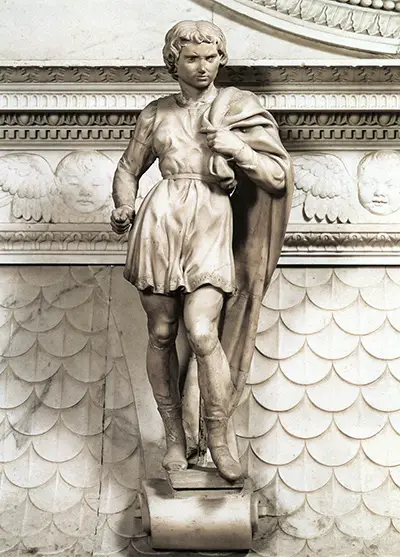By the time he was 26 he was engaged in the creation of possibly the most iconic figure ever produced in marble; the Biblical hero, David, which stands in the Accademia Gallery in Florence, Italy. But all masters have to hone and develop their art and we might reasonably consider whether those earlier statues in Bologna formed a significant part of Michelangelo’s journey towards his later, more famous, works. At 13 Michelangelo was apprenticed for 3 years to the busy workshop of the painter; Domenico Ghirlandajo. There, the young Michelangelo received a thorough grounding in painting and draughtsmanship techniques but his ideas about art were very different to those of his master.
He studied the work of other artists, in particular sculptures done by the ancient Greeks and Romans, as they seemed to have penetrated the secrets of how to sculpt the human body with all its musculature and fluidity of movement. Like his contemporary; the great Leonardo Da Vinci, Michelangelo refused to limit his anatomical education to the study of existing sculptures. He did his own research into human anatomy, dissecting bodies and sketching living beings until he had explored every aspect of the human form. By the time he was 30 he was acknowledged to be one of the great artists of the age. The Basilica San Domenico is one of the major churches in the beautiful city of Bologna.
It stands in the Piazza San Domenico, basking in the sunlit terra-cotta and pink shades of the city’s Renaissance architecture and it houses the remains of St Dominic, founder of the Dominican order. The sarcophagus holding these remains is situated in the middle of the church. It is wonderfully decorated with a crown above it. Between the sarcophagus and the crown, on a narrow ledge, stand a number of statues, including the three created by Michelangelo; St Petronius (patron saint of Bologna), St Proculus, and an un-named angel.
Michelangelo's representation of St Proculus (or St. Proclus, ‘San Proculo’, in Italian) is in marble and stands a modest 58.5 cm high. St Proculus is thought to have been a Roman officer who died around 304 AD. He is the military patron of Bologna. But Michelangelo gives us a sense of much more than an ancient Roman relic. His sculpture of the young Proculus breathes life and vitality. His clothes fold and sit comfortably on his slender frame, his expression is purposeful and he appears to have a mission in mind. Michelangelo has even taken the time to carve a delicate finish to the hem of the young man’s tunic.
It is difficult to imagine how such delicacy and the impression of movement could be created from a block of stone. The tools that Michelangelo used would have been more or less the same as those used by the ancient Romans and Greeks he had so admired. A mason’s axe would be used to cut out the basic shape, followed by a variety of hammers, mallets, drills and chisels to create detail. To achieve a smoother finish, rasps and stone grit would be employed and, finally, marble was polished with pumice stone to leave a fine, translucent surface.
Marble is a brittle stone and supports were often used to attach more delicate limbs to the main body of the sculpture. One might suggest that this is why Michelangelo kept the arms of St Proculus close to his body, with his cloak slung over his shoulder to give some stability. Standing and gazing up at the athletic form of St Proculus, it takes little imagination to conclude that this particular figure must have had some influence over Michelangelo’s later wondrous creation of David.


